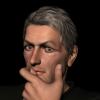A Question About the Transfer Utility
 Mage 13X13
Posts: 435
Mage 13X13
Posts: 435
Can the Transfer Utility tool be used to transfer gen 3 and 4 rigging to products made for those figures? I ask because I have an idea for a product I wish to create that would need the rigging to work.
Thanks!


Comments
It is only for TriAx weight mapped figures like Genesis and G2F and M.
Have a look here to see more info about it: http://docs.daz3d.com/doku.php/public/software/dazstudio/4/referenceguide/interface/action/index/dztransferutilityaction/start
and here : http://docs.daz3d.com/doku.php/public/software/dazstudio/4/userguide/creating_content/rigging/tutorials/basics_initial_rig_with_transfer_utility/start
What you can do is import the V3 or V4 figure into the Figure Setup pane, load the grouped geometry and then use the figure as a donor so that you get the original fall-offs on the new item.
Load the figure and select it, then in the Figure Setup pane's option menu (lined button in the top corner, or right-click the tab) click Copy from Selected Figure. Now right-click in the Geometry List and select Add Geometry... and import your OBJ (which, as I said, must already be grouped to show which bit belongs to which bone): if you plan to export to CR2 the OBJ must be made to Poser scale. Now drag the new OBJ from the Geometry List to the Relationships area, and it will replace the original geometry for all the bones it has; delete unneeded bones by right-clicking on them, but generally keep the first bone that doesn't have mesh in your item that is attached to a bone that does and simply remove the previous figure's geometry (right-click again). Click the Modify Selected Figure box at bottom left and then create the figure.
The product I want to create is a mechanized suit which would be worn like an open exoskeleton. The parts would be jointed in such a way as to match and move with those of the figure. I don't know much about falloff zones, but I do know it has something to do with the deformation of meshes when a figure is posed. In this case nothing like that would be needed, since the parts would all be rigid sections that fit around the body parts of the figure somewhat loosely. It would be like a suit that enhances the strength and speed of a human, but you would be able to see the human in it. The reason I want to use the rigging of the figure is that the parts would move with the posing of the figure, similar to the way conforming clothing does, but without deforming the meshes in the suit. The suit itself would be about 15% larger than its wearer and would be attached to the wearer at the wrists, ankles, and possibly the waist, and neck. I'm planning the modeling start up in a couple of weeks. It might be possible to parent each part to the corresponding bone in the figure's rigging. I am looking at several options on how to do what I want, and the best one will be what I choose. I do have much to learn about all of this, but if I can do it, the results should be spectacular.
If you want it to conform the joint centres still have to match, so you'd go through the process I describe above to create the base figure. However, if you were going to add things like pistons you'd need groups for them (the usual trick is two bones per piston, so you can attach them by their hinged ends to the figure bone they match and then set them to point at each other) but once you have the figure you'd select all of the bones, go to Parameters and click the Bend button off so each piece moved rigidly (and then you'd use the joint editor tool to fix up additional parts such as pistons).